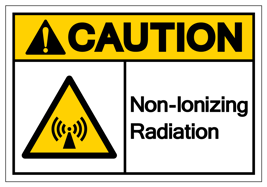
The US federal Occupational Safety and Health Administration (OSHA) regulates workplace exposures to radiation, in two separate standards that distinguish between “non-ionizing” and “ionizing” radiation. OSHA’s Non-ionizing Radiation Standard (29 CFR 1910.97) addresses workplace exposures to electromagnetic waves from radio and microwave sources. OSHA has established radioactive exposure levels intended to protect exposed employees, and requires placarding to inform those who enter areas bathed in non-ionizing radiation.
What non-ionizing radiation does OSHA regulate?
OSHA regulates employee exposure to what it refers to as “non-ionizing” radiation, which does not contain enough energy to ionize biologically important atoms in a worker’s body (this is “ionizing” radiation), but may pose a hazard because it generates heat in exposed skin and internal tissue. The non-ionizing radiation standard covers “electromagnetic radiation,” which OSHA defines to include radio and microwave frequency emissions.
This Standard covers electromagnetic radiation originating from radio stations, radar equipment, and other possible sources of electromagnetic radiation such as those used for communication, radio navigation, and industrial and scientific purposes. Although the Standard does not provide additional details, OSHA’s Safety and Health Topic webpage for non-ionizing radiation provides a listing of common types and sources:
-
Extremely Low Frequency (ELF) radiation - at 60 HZ is produced by power lines, electrical wiring, and electrical equipment.
-
Radiofrequency and Microwave radiation (MW) – from sources including radio emitters and cell phones
-
Infrared (IR) radiation (absorbed as heat) - Sources include furnaces, heat lamps, and IR lasers.
-
Visible Light radiation
-
Ultraviolet radiation (UV) - Sources include the sun, black lights, welding arcs, and UV lasers.
-
Lasers
The Standard does not apply to the deliberate exposure of patients by, or under the direction of, practitioners of the healing arts.
What must employers do to protect employees from exposures to non-ionizing radiation?
The Standard requires employer actions to protect potentially-exposed employees. Readers should note that the Standard does not explicitly require an employer to survey the workplace to identify locations where non-ionizing radiation exposures may occur.
- Are required radio-frequency hazard signs posted?
In work areas where workers may be exposed to non-ionizing radiation, the employer must post a radio frequency radiation warning symbol. This sign is a red isosceles triangle above an inverted black isosceles triangle, separated and outlined by an aluminum color border. The words:
WARNING—RADIO FREQUENCY RADIATION HAZARD
appear in the upper triangle.
The employer may add additional warning information and/or precautionary instructions, in the lower triangle of the warning symbol.
- Does the employer limit employee exposures?
The Standard does not require employers to limit access to exposure areas, but OSHA has established maximum exposure levels, which it refers to as the Radiation Protection Guide (Guide). For normal environmental conditions the limit for exposure to electromagnetic energy of frequencies from 10 megahertz (MHz) to 100 gigahertz (GHz), the Guide is 10 milliwatt per square centimeter (mW/cm2), as averaged over any possible six-minute period.
This exposure level may be reached either of the following ways:
-
-
Power density: 10 mW/cm2 for periods of 0.1-hour or more
-
Energy density: 1 mW-hr/cm2 during any 0.1-hour period
-
These thresholds apply whether the radiation is continuous or intermittent, and apply to both whole body and partial body irradiation. Non-ionizing radiation of these strengths may be generated by radio transmitters, radar transmitters, microwave relays, and high-voltage electrical wires.
The Standard states that the Radiation Protection Guide “should not be exceeded without careful consideration of the reasons for doing so.” OSHA does not provide guidance for compliance with this vague directive.
What now?
Employers should remain attentive to these requirements, as they call for useful injury prevention efforts.
Self-evaluation checklist
Has the organization identified workplace non-ionizing radiation hazards, including from:
-
Extremely Low Frequency (ELF) radiation?
-
Radiofrequency and Microwave radiation (MW)?
-
Infrared (IR) radiation?
-
Ultraviolet radiation (UV)?
-
Lasers?
Does the organization post required warning signs in workplace locations where non-ionizing radiation hazards may be present?
Does the organization provide training to potentially exposed employees?
Does the organization survey each workplace periodically to ensure that all relevant hazards are identified and managed?
Where Can I Go For More Information?
-
OSHA
- Non-ionizing Radiation Safety and Health webpage
About the Author
 Jon Elliott is President of Touchstone Environmental and has been a major contributor to STP’s product range for over 30 years.
Jon Elliott is President of Touchstone Environmental and has been a major contributor to STP’s product range for over 30 years.
Mr. Elliott has a diverse educational background. In addition to his Juris Doctor (University of California, Boalt Hall School of Law, 1981), he holds a Master of Public Policy (Goldman School of Public Policy [GSPP], UC Berkeley, 1980), and a Bachelor of Science in Mechanical Engineering (Princeton University, 1977).
Mr. Elliott is active in professional and community organizations. In addition, he is a past chairman of the Board of Directors of the GSPP Alumni Association, and past member of the Executive Committee of the State Bar of California's Environmental Law Section (including past chair of its Legislative Committee).
You may contact Mr. Elliott directly at: tei@ix.netcom.com

